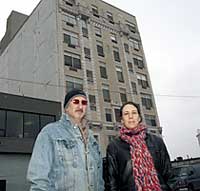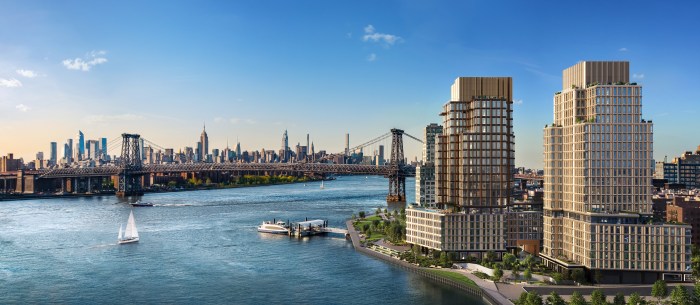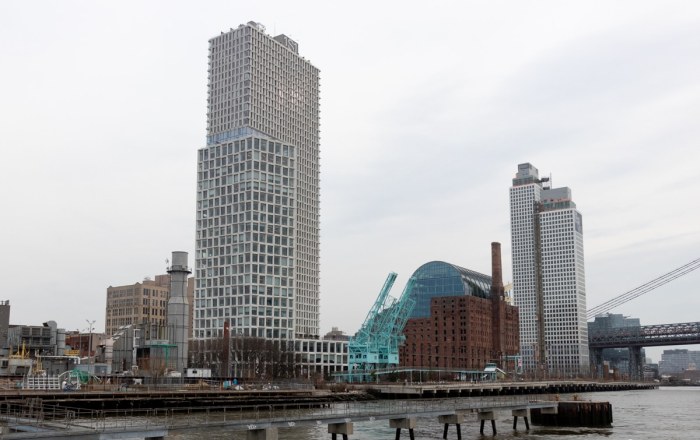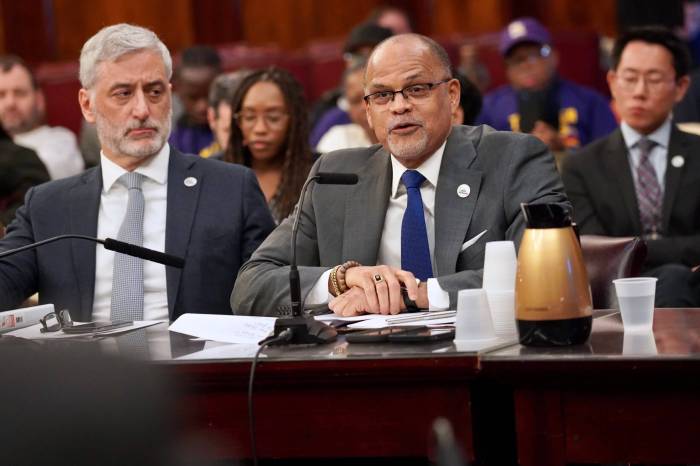From the outside, the old Ward Bakery building at 800 Pacific St. looks
like just another city relic — an abandoned, six-story building with
cement filling the spaces that were once windows.
But the century-old, terra cotta-tile building with Romanesque arches
may be one of the city’s treasures, according to the Prospect Heights
Historic Association, a group that formed to protect the Ward Bakery building
and at least two other area buildings from demolition should developer
Bruce Ratner’s plan for the creation of mega-blocks to house a professional
basketball arena, office towers and housing come to fruition.
The group seeks to get the buildings included on the National Register
of Historic Places.
Ratner’s Atlantic Yards project proposes a sweeping, 24-acre development
with a 19,000-seat basketball arena for his New Jersey Nets, residential
buildings and four soaring office towers. The Frank Gehry-designed project
would be built over Long Island Rail Road storage yards and is dependent
upon the state condemning more than two square blocks of private property
and knocking down up to 70 buildings.
“I was angered that an architect didn’t give second thought
to this lasting architecture to make room for his own,” said Nancy
Finton, who helped found the Prospect Heights Historic Association after
getting wind of Ratner’s plans.
In addition to the Ward Bakery, the group seeks to preserve the former
A.G. Spalding sporting-goods factory at 24 Sixth Ave., the Atlantic Art
Building at 636 Pacific St., and the former Daily News printing plant
at 700 Pacific St., the only building of the four not slated for demolition
under the Ratner arena plan.
All three are now luxury apartment buildings.
“I grew up in the suburbs and love living in a place that has a sense
of a past,” said Finton.
Asked about bringing in Gehry — noted for the Guggenheim Bilbao museum
in Spain and the Disney Concert Hall in Los Angeles — Finton said,
“I’m not crazy about Frank Gehry. I feel like he’s become
very trendy and his work is likely to look dated in another 10 or 20 years.
Spokesmen for Gehry and Ratner declined to comment on the preservation
efforts.
While a listing on the National Register would not guarantee the buildings’
survival, it would give preservationists a seat at the table, said Simeon
Bankoff, executive director of the Historic Districts Council, a non-profit
preservation group.
The Empire State Development Corp. is expected to be the lead agency on
the Atlantic Yards project.
If the buildings were placed on the National Register, said Cathy Jimenez,
a spokeswoman for the state Office of Parks, Recreation and Historic Preservation,
“[The Atlantic Yards developers] would have to show that there is
no other possible alternative to demolition, that it is absolutely a last
resort.”
Downtown landmarks
In a related effort, the Brooklyn Heights Association has joined forces
with the Municipal Art Society to seek the city landmark designation of
16 buildings in Downtown Brooklyn that could face demolition as part of
the Downtown Brooklyn Plan.
The plan would use the state’s power of eminent domain to condemn
and demolish buildings in order to create mega-blocks that might eventually
house 5.5 million square feet of office space and 1,000 new apartments.
“Rather than encouraging new development from the ground up, we suggest
promoting adaptive reuse, mixing ground-floor retail with residential
uses on the floors above,” the Municipal Art Society explained in
testimony delivered at a public hearing on the plan last month.
The Brooklyn Heights Association has sent a list of the buildings to the
city Landmarks Preservation Commission.
Three Downtown properties are facing the most imminent threat, according
to Vicki Weiner, a Kress Fellow for historic preservation with the Municipal
Art Society.
Those include the beaux-arts style former Board of Education offices at
131 Livingston St., a three-story clapboard house at 233 Duffield St.
and three buildings with cast-iron commercial facades at 567-571 Fulton
St.
“We don’t feel that it’s too late,” Weiner said of
the preservation efforts.
“We don’t think of efforts of preservation on Fulton Street
as against the [Downtown] plan in any way,” she said. “We think
it is compatible with it — no matter what happens with the plan you
have Fulton Street. We would like to see it revitalized and the buildings
made full use of, because some of the buildings are really magnificent.”
Department of City Planning spokeswoman Rachael Raynoff said the agency
was interested in the preservation efforts in the area. City Planning
is the lead agency on the Downtown Brooklyn Plan.
“Chair [Amanda] Burden has reached out to local civic groups to use
our collective resources and expertise to work together with the Municipal
Art Society to look at some of these buildings and some of the goals the
Municipal Art Society has outlined,” Raynoff said.
As for the next steps, Finton says the Prospect Heights Historic Association
is busy researching the properties.
“It’s incredible that they could even consider tearing down
these amazing buildings,” said Rodney Ripps, a Crown Heights native
and painter who lives at 700 Pacific St.
Added Ripps, co-chair of the Prospect Heights Preservation Association,
“Those buildings are the heritage of Brooklyn.”






















